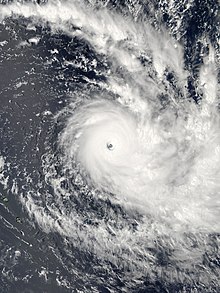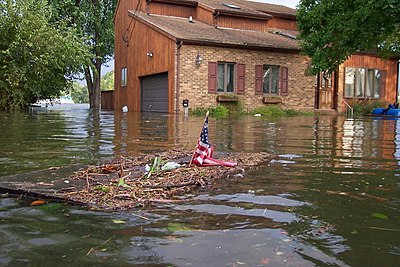
Back بوابة:الأعاصير المدارية Arabic Portal:Ciclons tropicals Catalan Portal:Ciclones tropicales Spanish 포털:태풍 Korean Portaal:Tropische cyclonen Dutch Portal:Ciclones tropicais Portuguese สถานีย่อย:พายุหมุนเขตร้อน Thai Portal:熱帶氣旋 Chinese
The Tropical Cyclones Portal

A tropical cyclone is a storm system characterized by a large low-pressure center, a closed low-level circulation and a spiral arrangement of numerous thunderstorms that produce strong winds and heavy rainfall. Tropical cyclones feed on the heat released when moist air rises, resulting in condensation of water vapor contained in the moist air. They are fueled by a different heat mechanism than other cyclonic windstorms such as Nor'easters, European windstorms and polar lows, leading to their classification as "warm core" storm systems. Most tropical cyclones originate in the doldrums, approximately ten degrees from the Equator.
The term "tropical" refers to both the geographic origin of these systems, which form almost exclusively in tropical regions of the globe, as well as to their formation in maritime tropical air masses. The term "cyclone" refers to such storms' cyclonic nature, with anticlockwise rotation in the Northern Hemisphere and clockwise rotation in the Southern Hemisphere. Depending on its location and intensity, a tropical cyclone may be referred to by names such as "hurricane", "typhoon", "tropical storm", "cyclonic storm", "tropical depression" or simply "cyclone".
Types of cyclone: 1. A "Typhoon" is a tropical cyclone located in the North-west Pacific Ocean which has the most cyclonic activity and storms occur year-round. 2. A "Hurricane" is also a tropical cyclone located at the North Atlantic Ocean or North-east Pacific Ocean which have an average storm activity and storms typically form between May 15 and November 30. 3. A "Cyclone" is a tropical cyclone that occurs in the South Pacific and Indian Oceans.
Selected named cyclone -
Severe Tropical Cyclone Yasa was the second Category 5 severe tropical cyclone in 2020 after Harold in the 2019–20 South Pacific cyclone season. Yasa was the second tropical disturbance, as well as the first tropical cyclone and severe tropical cyclone of the 2020–21 South Pacific cyclone season. Yasa was first noted as an area of low pressure to the north of Port Vila in Vanuatu during December 10. Over the next few days, the system gradually developed further as it absorbed Tropical Depression 01F, before it was classified as a tropical cyclone and named Yasa by the Fiji Meteorological Service on December 13.
The system gradually moved through the South Pacific Ocean, going through a small, slow loop whilst rapidly intensifying. In about a day, it became a Category 5 severe tropical cyclone on the Australian scale and a few hours later, a Category 5-equivalent cyclone on the Saffir-Simpson scale, with 1-minute sustained winds of 260 km/h (160 mph) and a minimum pressure of 917 hPa (27.1 inHg). This made Yasa the earliest Category 5 tropical cyclone on both the Australian and Saffir-Simpson scales in the South Pacific basin since reliable records began, beating the old record by Cyclone Zoe in 2002–03. (Full article...)Selected article -
The effects of Hurricane Isabel in North Carolina were widespread, with the heaviest damage in Dare County. The hurricane made landfall in the Outer Banks of North Carolina on September 18. There, storm surge flooding and strong winds damaged thousands of houses. The storm surge produced a 2,000 feet (610 m) wide inlet on Hatteras Island, isolating Hatteras by road for two months. Several locations along North Carolina Highway 12 were partially washed out or covered with debris. Hurricane Isabel produced hurricane-force wind gusts across eastern North Carolina, knocking down trees and power lines. About 700,000 residents lost power due to the storm, although most outages were restored within a few days. The hurricane killed three people in the state – two due to falling trees, and the other a utility worker attempting to restore electricity. Damage in the state totaled $450 million (2003 USD, $745 million 2024 USD).
The National Hurricane Center issued a hurricane watch, and later warning, for the state's coastline in advance of the hurricane's landfall. Local officials issued evacuation orders for 18 counties, along with various flood warnings. In the aftermath of the hurricane, then-President George W. Bush declared a state of emergency for 26 counties in the state, which allocated federal resources to the state. Utility crews from nearby states helped restore power. The United States Geological Survey dredged sand to restore the breach on Hatteras Island, with traffic restored about two months after the hurricane. (Full article...)Selected image -
Selected season -

The 2007 Atlantic hurricane season was the first season since 2003 to feature tropical activity both before and after the official bounds of the season. There were an above-average number of named storms during the season – 15, however many storms were weak and short-lived. Despite the predominance of weak systems, this was the first season on record to feature more than one Category 5 landfalling hurricane. This would not happen again until 2017. It produced 17 tropical cyclones, 15 tropical storms, six hurricanes, and two major hurricanes. It officially started on June 1 and ended on November 30, dates which conventionally delimit the period during which most tropical cyclones form in the Atlantic Ocean, although as shown by Subtropical Storm Andrea and Tropical Storm Olga in early May and early December, respectively, the formation of tropical cyclones is possible at any time of the year. The first system, Subtropical Storm Andrea, developed on May 9, while the last storm, Tropical Storm Olga, dissipated on December 13. The most intense hurricane, Dean, was, at the time, the third most intense landfalling Atlantic storm on record. It was the second on record in which an Atlantic hurricane, Felix, and an eastern Pacific hurricane, Henriette, made landfall on the same day. September had a then record-tying eight storms, until it was surpassed in 2020. However, the strengths and durations of most of the storms were low.
Pre-season forecasts by Colorado State University called for 14 named storms and 7 hurricanes, of which three were expected to attain major hurricane status. The National Oceanic and Atmospheric Administration (NOAA) later issued its initial forecast, which predicted 13 to 17 named storms, 7 to 10 hurricanes and three to five major hurricanes. After several revisions in the projected number of storms, NOAA and CSU lowered their forecasts by the middle of the season. (Full article...)Related portals
Currently active tropical cyclones

Italicized basins are unofficial.
- North Atlantic (2024)
- No active systems
- East and Central Pacific (2024)
- No active systems
- West Pacific (2024)
- No active systems
- North Indian Ocean (2024)
- No active systems
- Mediterranean (2024–25)
- No active systems
- South-West Indian Ocean (2024–25)
- No active systems
- Australian region (2024–25)
- No active systems
- South Pacific (2024–25)
- No active systems
- South Atlantic (2024–25)
- No active systems
Last updated: 18:07, 9 July 2024 (UTC)
Tropical cyclone anniversaries

July 16,
- 2005 - Hurricane Emily (pictured) reached its peak intensity of 929 hPa (mbar) near Jamaica, becoming the strongest July tropical cyclone ever recorded in the North Atlantic basin.
- 2011 - Typhoon Ma-on briefly reached its maximum intensity as a Category 4 after interacting and absorbing another storm.

July 17,
- 1983 - Typhoon Vera hit the Philippines with winds of 140 km/h (85 mph) before moving into the South China Sea. Vera killed over 100 people in the Philippines and on Hainan Island.
- 2016 - Cyclone Abela becomes a tropical storm, marking the fourth occurrence of a tropical cyclone existing in the southwest Indian Ocean during the month of July
- 2021 - Hurricane Felicia (pictured) - An unusually small Category 4 Hurricane that became the strongest storm of 2021 Pacific Hurricane Season in July.

July 18,
- 2005 - Typhoon Haitang made landfall on Taiwan, causing numerous landslides and flash floods across the island.
- 2014 - Typhoon Rammasun (pictured) reached its peak intensity as a Category 5 super typhoon, being one of only two Category 5 typhoons on record to exist in the South China Sea. Overall damages over in China and in the Philippines had totaled to $7.13 billion and killing nearly 200 people.
Did you know…




- …that the Joint Typhoon Warning Center considers that Typhoon Vera (pictured) of 1986 is actually two distinct systems, formed from two separated low-level circulations?
- …that Hurricane Agatha (pictured) was the strongest Pacific hurricane to make landfall in Mexico in May since records began in 1949?
- …that Cyclone Raquel (track pictured) travelled between the Australian and South Pacific basins between the 2014–15 and 2015–16 seasons, spanning both seasons in both basins?
- …that Cyclone Amphan (pictured) in 2020 was the first storm to be classified as a Super Cyclonic Storm in the Bay of Bengal since 1999?
General images -

The 1983 Atlantic hurricane season was an event in the annual tropical cyclone season in the north Atlantic Ocean. It was the least active Atlantic hurricane season in 53 years, during which four storms formed. The season officially began on June 1, 1983 and ended November 30, 1983. These dates, adopted by convention, historically describe the period in each year when most systems form. The first named storm, Hurricane Alicia, formed on August 15. The last storm of the season, Tropical Storm Dean, dissipated on September 30.
This season produced seven tropical depressions, of which four became named storms; three attained hurricane status, of which one became a major hurricane, a storm that ranks as a Category 3 or higher on the Saffir–Simpson scale. The most notable storm in 1983 was Hurricane Alicia, which killed 21 people and caused $2.6 billion (1983 USD; $5.6 billion 2008 USD) in damages, making it the costliest storm, at the time, in Texas history. As a result of its intensity, the name Alicia was subsequently retired from reuse in the North Atlantic by the World Meteorological Organization. Another notable storm, Hurricane Barry, made landfall on Florida as a tropical storm, then, after crossing into the Gulf of Mexico crossing, strengthened into a weak Category 1 hurricane that traveled almost due west across the Gulf before making landfall in extreme northern Mexico. (Full article...)Topics
Subcategories
Related WikiProjects
WikiProject Tropical cyclones is the central point of coordination for Wikipedia's coverage of tropical cyclones. Feel free to help!
WikiProject Weather is the main center point of coordination for Wikipedia's coverage of meteorology in general, and the parent project of WikiProject Tropical cyclones. Three other branches of WikiProject Weather in particular share significant overlaps with WikiProject Tropical cyclones:
- The Non-tropical storms task force coordinates most of Wikipedia's coverage on extratropical cyclones, which tropical cyclones often transition into near the end of their lifespan.
- The Floods task force takes on the scope of flooding events all over the world, with rainfall from tropical cyclones a significant factor in many of them.
- WikiProject Severe weather documents the effects of extreme weather such as tornadoes, which landfalling tropical cyclones can produce.
Things you can do
 |
Here are some tasks awaiting attention:
|
Wikimedia
The following Wikimedia Foundation sister projects provide more on this subject:
-
Commons
Free media repository -
Wikibooks
Free textbooks and manuals -
Wikidata
Free knowledge base -
Wikinews
Free-content news -
Wikiquote
Collection of quotations -
Wikisource
Free-content library -
Wikiversity
Free learning tools -
Wikivoyage
Free travel guide -
Wiktionary
Dictionary and thesaurus
© MMXXIII Rich X Search. We shall prevail. All rights reserved. Rich X Search
























































